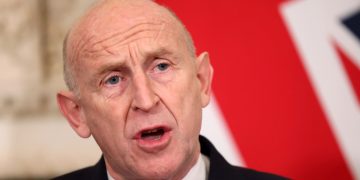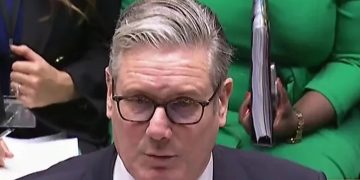
The College of Policing has put forward proposals aimed at ending years of police secrecy and suspicion in their dealings with journalists in the wake of the Leveson Inquiry.
In addition, Operation Elveden, which closed in 2016, saw 34 journalists arrested in relation to alleged payments to public officials (although there was only one conviction). Nine police officers were convicted.
Since then there has been a sharp decline in police relations with the police.
For three years, College of Policing guidance bracketed journalists with criminals and people in extremist groups as individuals police staff had to disclose any association with. This was finally retracted in March.
A number of UK journalists have been arrested and detained whilst trying to cover protests in recent years.
Police refusal to provide off-the-record guidance to the media fuelled a wave of misinformation during the disappearance of Nicola Bulley in Lancashire in 2023.
Since then new guidance has enabled police to provide early details around the nationality and ethnicity of suspects to curb the spread of misinformation, as was the case with the suspect accused of stabbing ten people on a train in Cambridgeshire on Saturday night.
The new draft guidance for police forces in England and Wales, which is out to consultation for two months, seeks a reset of police-media relations.
It states: “Officers and staff of all ranks and roles are encouraged to provide factual information to the media concerning operational incidents or investigations.”
The guidance addresses a number of concerns highlighted by crime reporters, recommending:
- More background guidance for the media
- Pictures to be provided to media when convictions result in custodial sentences
- More openness around police misconduct cases
- An acceptance that journalists and reporters should not be hindered from reporting at the scene of incidents.
Chief executive of the College of Policing Andy Marsh told Press Gazette: “This is intended to not only reset the relationship [with journalists] but reset the sort of information that the police and public can expect to get from the police – namely that it’s ethical, transparent, consistent, impartial and intended to support their purpose of cutting crime.
“And if we don’t have the trust and confidence of the public we will not be able to cut crime.
“It’s guidance that is intended for all of policing so the public can expect us to be much more forthright in explaining what we are doing, what we are not doing and why we are doing it.
“I hope people contribute to the consultation and help make it even better because I think this a big step in the right direction.”
National Police Chiefs’ Council lead for media and communications deputy chief constable Sam De Reya said: “What we’ve found over the last couple of years is the pace and environment has changed so much. We’ve got keep pace around that and run alongside it.
“The narrative around policing is so negative and there’s so many brilliant things our people do every day out there keeping people safe. By building that better relationship it would be good to get more of a balance around the good that is in policing and how we look after our communities.”
The new guidance does not tackle media concerns about police press offices not providing telephone contacts.
Another concern not addressed is around police forces undermining the ability of freelance court reporters to operate by providing press releases around guilty verdicts.
These reports, released instantly on conviction, are often used verbatim by publishers but offer only one side of a case and do not cover not-guilty cases.
On this point Marsh said: “We want good journalists to be able to sit in court, we recognise the challenge you face with capability and finance, but where it is possible we would certainly support and enable it.”
‘Major step’ towards rebuilding police-media relationship
Daily Mail crime editor, and chair of the Crime Reporters Association, Rebecca Camber said: “Today’s draft guidance represents a major step towards the rebuilding of a successful working relationship between police forces and the media which remains essential to public confidence and policing legitimacy in the UK.
“Two years ago, the Nicola Bulley review warned the Leveson Inquiry had cast a decade-long shadow fracturing the relationship between the police and the media.
“Now, for the first time engagement between officers of all ranks and the media is being positively encouraged, forces are being told to open up and respond at pace in major investigations.
“The walls are finally coming down and I’m delighted that the College of Policing has accepted the recommendations of the Crime Reporters Association, the Society of Editors and the Media Lawyers Association on how we can work better together.”
Key points from the draft Authorised Professional Practice issued by the College of Policing
New culture of openness:
“As a simple rule, police officers and staff should ask, ‘Am I the person responsible for communicating about this issue and is there a policing purpose for doing so?’ If the answer to both parts of this question is ‘yes’, they should communicate with the media.
“Officers and staff of all ranks and roles are encouraged to provide factual information to the media concerning operational incidents or investigations.
“Police officers at all levels are expected to have some contact with the media as a routine part of the job.
“Chief officers should record all their contact with the media where policing matters are discussed. This record should be publicly available. A brief record that the conversation has taken place and of its subject matter is sufficient. Informal or chance meetings where work-related issues are not discussed need not be recorded.
“Responses to media enquiries about investigations or police activity should be open, honest and transparent. Clear reasoning should be recorded if a decision is made to withhold information because its release would have a detrimental impact on the investigation or operation.
“The journalist must provide sufficient additional detail to identify an investigation or incident, without reference to a named person, before being provided with information about the investigation.”
Background guidance:
“Non-reportable information is provided to the media on the basis (by prior agreement) that it is for guidance only and not for publication or broadcast. It can be used to provide further context around a statement. This enables the police to have a dialogue with the media about serious or sensitive policing issues without generating publicity about them.
“Properly used, this may be a valuable resource in the context of an established, trusting and professional relationship.”
Naming of suspects before charge:
“Suspects should not be identified to the media (by disclosing names or other identifying information) prior to the point of charge, except where justified by clear circumstances, such as a threat to life, the prevention or detection of crime, or a matter of public interest and confidence.
“When someone is arrested, police can proactively release the person’s gender, age, the place – for example, the town or city – where they live, the nature, date and general location of the alleged offence, the date of the arrest, whether they are in custody or have been bailed, any subsequent bail date, or if they were released without bail or with no further action being taken.
“If a name or names are put to the police with a request for confirmation of an arrest, the response should be ‘we neither confirm nor deny’. No guidance should be given. Police should not respond by supplying other information that, although not directly naming an arrested person, would nevertheless have the effect of confirming the person’s identity.”
The right to report from live incidents:
“Reporting or filming from the scene of an incident is part of the media’s role and they should not be prevented from doing so from a public place. Police have no power or moral responsibility to stop the filming or photographing of incidents or police personnel.
“It is for the media to determine what is published or broadcast, not the police. Once an image has been recorded, the police have no power to seize equipment, or delete or confiscate images or footage, without a court order.”
Protecting exclusives:
“Media organisations should be treated in a fair and impartial manner. Where a media organisation generates an exclusive, their right to share information in confidence with the police should be respected.
“There are occasions where targeting a particular media organisation by offering them a specific story is appropriate, such as a story or campaign based on geography, a particular audience or community that the force wishes to reach, or a media organisation’s particular interest in a certain issue.”
Information after charge:
“Those charged with an offence – including those who receive a summons to court – should be named, unless there is an exceptional and legitimate policing purpose for not doing so or reporting restrictions apply. This information can be given at the point of charge.
“The police, as the legal copyright owner, are responsible for releasing an offender’s custody photograph. The image may be released upon a guilty verdict unless there is a court order or legitimate policing purpose preventing their identification.
“Images may be released as soon as possible after the verdict to allow the media to publish them contemporaneously (in their next available edition or broadcast). The image can be released again upon sentence if necessary.”
Police misconduct:
“Media lines should be proactively released if officers are charged in relation to off-duty activities that involve serious criminality (for example, sexual offences, serious assaults, fraud or corruption) or matters that could seriously damage public confidence in the police service or call its integrity into question.
“If officers are charged with or summonsed for a criminal offence committed on duty, their details should be proactively released.
“Misconduct hearings are held in public where the case to be heard applies to gross misconduct (which can lead to dismissal), in accordance with legislative changes effective from 1 May 2015.
“There is a requirement that notice will be given for a hearing that is to be held wholly or partly in public in the absence of a compelling reason for not doing so.
“Where notice is required, this must be published by the appropriate authority on its website at least five working days before the day on which the hearing is due to take place.
“At the conclusion of a misconduct hearing, there is a requirement that the outcome of a case is published within a predetermined timeframe. The legally qualified chair may determine what will be published in this outcome notice.”
The post New police media guidance aims to rest post-Leveson culture of suspicion appeared first on Press Gazette.





























